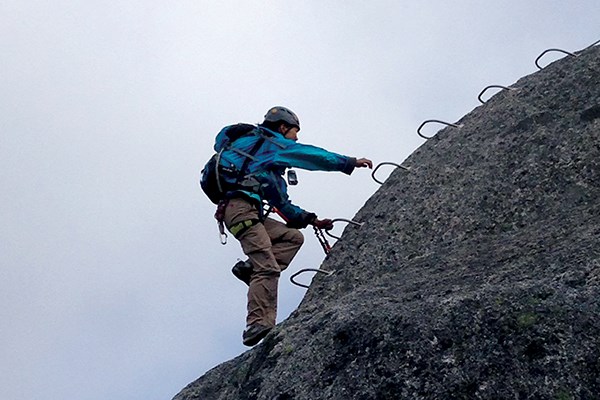The Sea to Sky Gondola has recently partnered up with the newly formed Sea to Sky Guides to bring something relatively new to the Canadian outdoor tourism scene: a via ferrata.
Long enjoyed as an outdoor activity in European countries, the via ferrata is still a new thing here in North America. Originally used in parts of Italy and Switzerland as a way to move troops in hazardous terrain during the First World War, via ferratas became a form of recreation and a source of tourism dollars after the war for the nearby mountain villages.
Not hiking and not quite mountaineering, via ferratas developed their own guidebooks and grading systems, sprung up in almost every European nation and now cover everything from simple easy cliff ascents to multi-day treks reaching multiple huge rock summits with overnights spent in huts enjoying fondues.
What is a via ferrata? It’s a ladder of metal rungs installed into a cliff face with a cable running alongside onto which you clip, safely ascending the height of the cliff without ropes or belayer. It’s like soloing an easy rock climb, except you’re not climbing the rock.
I’ve heard it referred to as mountaineering on training wheels but I’d rephrase that as scooter Alpinism. Why? Training wheels help a child learn how to ride a bike, with those wheels getting removed when the real day comes, come hell or high water. A scooter can be a tool to help a child learn similar balance to riding a bike, but it could also stand alone as a fun two-wheeled vehicle.
Experiencing a via ferrata could help someone develop the confidence and motivation to learn how to climb, but it could also simply be a way of enjoying a vertical environment in a beautiful place, an end in itself.
I recently had a chance to try our newly minted West Coast rainforest via ferrata. I turned off my climber goggles, hoping to see the via ferrata as someone new to mountains, cliffs, moss and heights might see it. Riding up in the gondola, surrounded by swirling mists and drizzle, my guide Teresa Yau assured me that climbing a via ferrata is possible even in dramatic weather. We suited up in harnesses, leashes, helmets, raingear and a small daypack for food, water – and an iPhone for selfies on our backs. A young gondola staff member named Thor educated me on how to correctly take selfies.
We hiked down through the misty subalpine rainforest, with Teresa giving us a simple lesson on how to correctly clip and unclip our leashes during the ascent. Before I knew it I was clipping my lobster claws into the beefy stainless steel cable and grabbing my first rung. I was underway.
As you climb the via ferrata, you swap your leashes around the bolts installed in the rock, always keeping one clipped while the other leaves the cable. This way you’re always swapping one safety system for the other, overlapping systems at each bolt, never disconnecting yourself completely during the entire ascent. The route we took didn’t straight-line it for the top but instead wove through the natural cracks, corners, bulges and ledges, taking you on an exploration of the terrain as someone might while rock climbing.
We pulled over bulges, traversed airy catwalks, climbed out of hemlock-covered ledges and balanced up arêtes on our way back to the summit lodge. The entire way, you can’t help but crane your neck around in every direction, even while stepping up the rungs, in fear that you might miss something from the landscape spreading out below. You’re not sitting in the lodge looking through glass out at the vista; instead, you are out there, part of the landscape itself.
As I walked, scrambled and climbed hand over hand up the rungs, clipping and unclipping my leashes around the bolts, I began to get the sneaky feeling I do when I’m climbing high up on a multipitch rock climb – something up on the Chief, for example. It’s that feeling of being happily lost up high, deeply nestled into the folds of a huge granite mountain, lost in that hard, unyielding embrace that does not judge but only holds you. Difficult for anyone to see, you have to read your way up, guessing and interpreting the wall’s secrets. As a climber I’ve come to cherish this feeling, so when this via ferrata made me feel something similar, I took it as a good omen. Someone new to being up on a face and enjoying the exhilaration could start to feel this up here.
If the Sea to Sky Gondola lets you scrape the surface of wilderness experiences, the via ferrata gives you a trowel to explore a little deeper into that soil. Time will tell whether people will begin to use the trowel to find the rabbit holes that lead to climbing and wilderness travel.
After the climbing goggles were back in place, I surmised that although I may not trade via ferrata for climbing, I would try my very best to sell my Dad on it. If you’ve ever parked and watched climbers up on the walls of the Chief and wondered, then a via ferrata may be for you.




